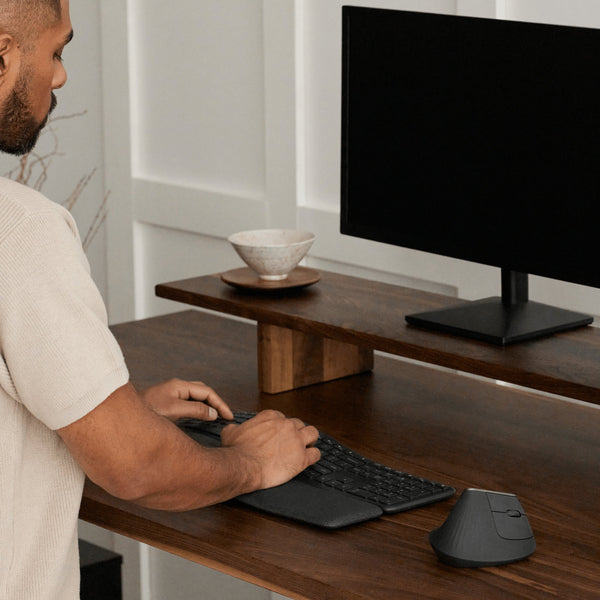How To Reap The Rewards Of Using Standing Desks
The benefits of using standing desks, such as increased energy, improved well-being, and enhanced productivity, are vast and well-known. Yet not enough people know how to get the most from their good investment when they first start using their standing desk. When adding the habit of standing while working to your routine, it's important to take it slowly and to be mindful of your body. Keep in mind, too much of a good thing can turn out to be just as damaging. Your ultimate goal should not be to go from a fully sedentary worker to an all-day standing marathoner. The goal must be to move more and sit less. Here are the DO’s and DON’Ts to keep in mind as you become more familiar with your standing desk:
Do’s: How to Use Your Standing Desk for Better Health and Productivity
Do Start Slow: Your Body Needs To Adjust
If you've been sitting at a desk for 10 years, you'll want to start gradually and work your way up to an ideal number of standing hours. If you're right out of college and beginning your first desk job, you might find your adjustment period shorter than average. Either way, neither of you would attempt a 300lb deadlift at the gym on your first day! So don’t be unrealistic with your body’s threshold for standing endurance from day one.
Make it your goal to stand for only 1 hour per day at first. It may not seem like much, but the last thing you want to do is overexert your body, and give up before you’re ahead. You can gradually increase the amount of standing time by 5-10 minutes per week. As you get used to standing for longer periods of time, you can slowly work your way up to the ideal range.
Do Use Proper Posture While Standing
In addition to the obvious tip of standing up straight, there are additional adjustments you can make to avoid muscle pain while standing. It's important to maintain a neutral neck position, keep your shoulders back, your wrists straight, and your elbows at a 90-degree angle. These simple ergonomic considerations all play a part in keeping you pain-free while standing. For additional tips, we encourage you to spare a few moments to go through our tutorial.
Do Focus on Moving More Than Just Standing
The best way to break up your workday between sitting and standing sessions is often debated. Whether you want to switch positions every 20 minutes, stand for 45 minutes then sit for 15, or try a 1:1 / 3:1, any and all choices are up to you. The key is to avoid inactivity, so as long as you switch things up, you really can’t go wrong. Make sure the frequency of posture transitions are given priority over extended standing sessions. You may want to show off how long you can stand, but it will do you more harm than good in the end. So take breaks, shift your weight, do some stretches, walk a short distance, whatever feels best!
Don’ts: Tips to Prevent Body Pains and to Personalize Your Work Experience
Don’t Stand For Longer Than You Should
What’s the ideal ratio of standing versus sitting? This is probably the most frequently asked question for first-time users of standing desks. A study from the University of Waterloo says the golden ratio for standing-to-sitting time is between 1:1 and 3:1. This means you should aim to stand one hour for every hour you spend sitting as a minimum, and ideally you should stand for up to 3 hours for every 1 hour you spend sitting. To break it down in the context of typical office hours, this means that in an 8-hour workday you should aim to stand between 4 to 6 hours. These daily totals should be broken up into smaller sessions, so that you may frequently alternate between standing and sitting. To prevent body pains, make sure to spend no longer than 1.5 hours at a time standing, and no longer than 30 minutes at a time sitting.
Don’t Be Afraid to Choose Your Own Adventure
There is no consensus on which tasks are best suited for a particular position. Some individuals feel more alert and focused while standing, so they may prefer to engage in concentration-intensive activities like writing. Others may opt to stand for tasks that require less focus, such as reading. Typically, people prefer to sit when performing tasks that require fine motor skills or precision; they often opt to stand during presentations or meetings to inject energy into their voice and create a more dynamic conversation.
Whether you choose to spend your standing time responding to emails, taking calls, reading reports, or writing the next Great American Novel like Hemingway did with his standing desk, the freedom of choice and movement makes using standing desks a highly personalized experience.
Quick Overview Of Office Sit-Stand Goals
ULTIMATE GOAL: Move more, sit less.
MINIMUM STANDING TIME: 5-20 minutes per hour.
REASONABLE STANDING TIME: 50% of your workday (~ 4hrs).
MAXIMUM STANDING TIME: 80% of your workday (~ 6 hrs).
IDEAL STANDING SESSION: 1.5 hours at a time.
IDEAL SITTING SESSION: 20 minutes at a time.
MOVEMENT FREQUENCY: Switch, stretch, or walk every 20 minutes.
Sources
- https://notsitting.com/54/proper-height/
- http://www.makeuseof.com/tag/5-things-youre-wrong-standing-desk/
- https://www.multitable.com/find-the-ideal-height-for-your-standing-desk/
- http://www.healthline.com/nutrition/6-tips-for-using-a-standing-desk
- https://uwaterloo.ca/health/how-long-should-you-stand-rather-sit-your-work-station
- http://www.cnn.com/2015/08/06/health/how-to-move-more/index.html
- https://www.outsideonline.com/1989241/how-long-should-i-be-standing-my-desk-every-day
- https://www.standupdeskstore.com/standing-news/finding-your-perfect-sit-to-stand-ratio/
- http://healthland.time.com/2011/04/13/the-dangers-of-sitting-at-work%E2%80%94and-standing/






Leave a comment